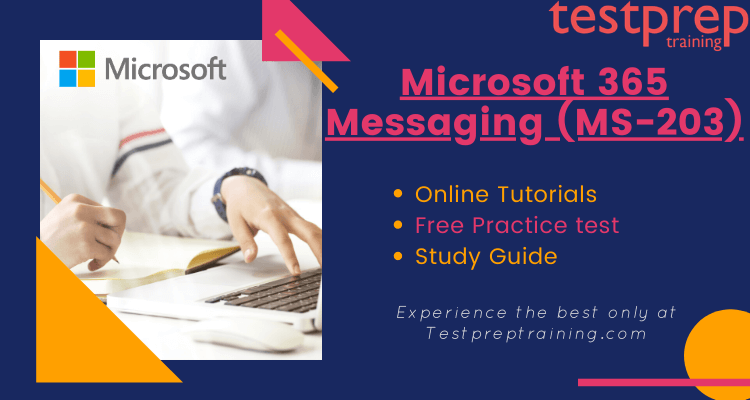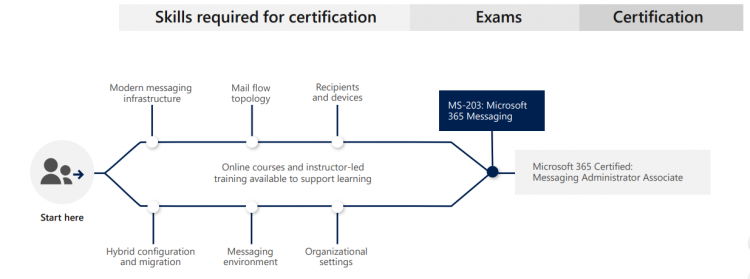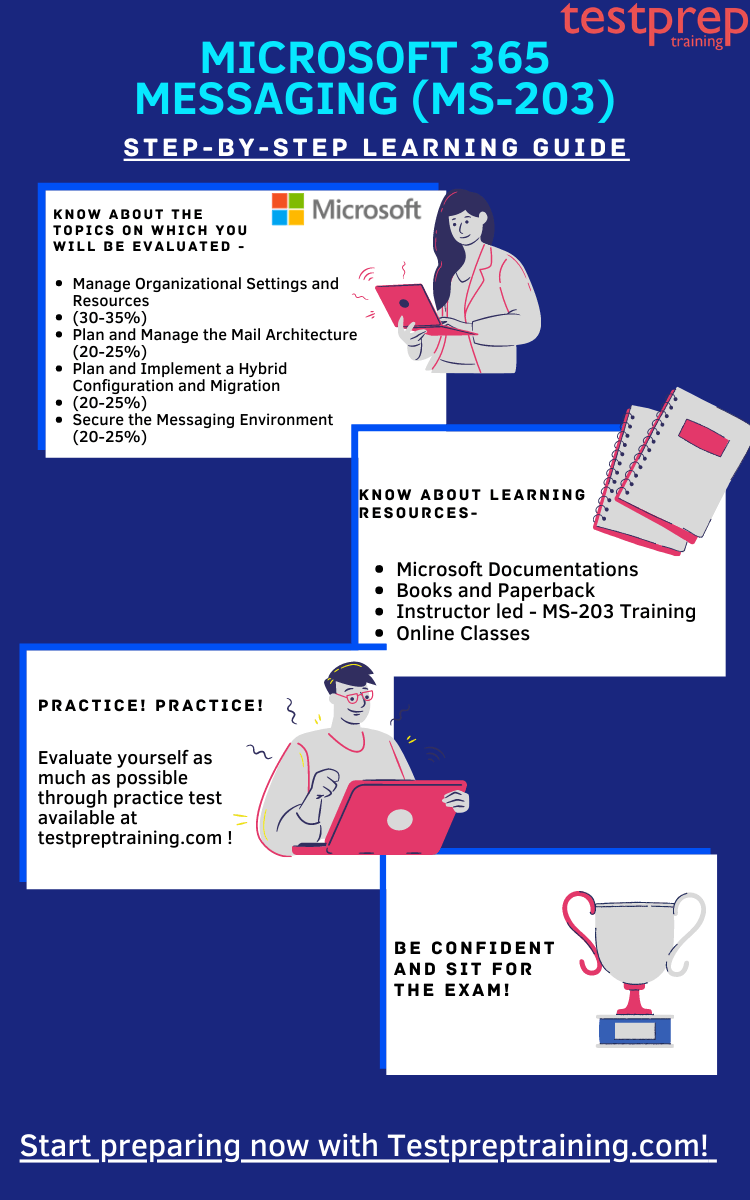Exam MS-203 Microsoft 365 Messaging

Microsoft 365 Messaging (MS-203) exam prepares you to execute the activities of a Messaging Administrator in hybrid and cloud enterprise systems, including deploying, configuring, managing, troubleshooting, and monitoring recipients, permissions, mail protection, mail flow, and public folders. You must keep yourself up to speed with the newest developments in order to live. Obtaining certificates is one technique to obtain an advantage over others. Certifications also demonstrate your commitment to your goals and progress. Let’s take a closer look at this useful certificate.
About Microsoft 365 Messaging (MS-203) Exam
The Microsoft MS-203 exam prepares you to work as a Messaging Administrator in hybrid and cloud enterprise systems, including deploying, configuring, managing, troubleshooting, and monitoring recipients, permissions, mail protection, mail flow, and public folders. Messaging Administrators work with the Security Administrator and the Microsoft 365 Enterprise Administrator to set up a secure hybrid or cloud-only architecture that satisfies an organization’s business demands.
Required Skills:
As a Messaging Administrator, you should be familiar with authentication types, licence, and Microsoft 365 application connectivity. Microsoft Messaging Administrators are also in charge of:
- Managing hygiene
- Messaging infrastructure
- Hybrid configuration
- Migration, transport
- Mailboxes
- Client access.

Skills Acquired
The MS-203 Practice Exam for Microsoft 365 Messaging assesses your ability to manage organisational settings and resources, plan and manage the mail architecture, plan and implement a hybrid configuration and migration, and protect the messaging environment.
Exam Details
| Name of the exam | Microsoft 365 Messaging (MS-203) |
| Code of the exam | MS-203 |
| No. of questions | 40-60 |
| Format of questions | multiple-choice, multiple select, case studies and fill in the blanks |
| Cost of exam | $165 |
| Duration of exam | 120 minutes |
| Languages available | English |
| Scheduling platform | Pearson VUE |
| Passing score | 700 (on a scale of 1-1000) |
How to register for the exam MS-203 exam?
Follow the steps written below to register for the exam:
- Go to the Microsoft site and find your certificate in the list. Then select schedule exam, to register.
- If the certificate will be available for your country then you will be able to select the exam during the registration process.
- You will also select the language of the greeter, proctor, and proctoring software.
Exam Retake Policy
- If you are unable to pass the exam in first attempt, the you must at least wait 24 hours before retaking the exam. You cannot retake the exam if you achieve a passing score.
- If you fail to pass the exam in second attempt too, then you must wait for a period not less than 14 days, in order to retake the exam. This is the same process for the failure in third, fourth or fifth attempt.
- You will not be allowed to give the exam more than 5 times a year. This year, 12-month period starts on your failure on 5th attempt. If you wish to give the exam more than 5 months a year then you have to contact Microsoft.
Academic pricing on the certifications
In most countries, academic pricing on Microsoft Certified Professional tests is provided (except India and China). To be eligible for academic price, you must verify your student status before booking your exam.
- Applying student status through your account profile
- Sign in with your Microsoft account credentials.
- Select Profile settings from the Account menu at the top of the page.
- In the Job function menu, select, or ensure that you have selected, “Student.”
- Look for the academic pricing notice that appears next to the Job function menu. If your student status has not yet been validated, click “Get verified” to verify your status.
- Applying student status when registering for an exam
- Sign in with your Microsoft account credentials.
- On the exam for which you want to register, click Schedule exam.
- On the Confirm your exam registration details page, ensure that the Job function field displays “Student – Verified.” If it does not, click “Get verified” to validate your status, or click Edit to change your status.
Verifying your academic status
Select the method you wish to use to verify your status. The methods include:
- School-issued email account
- School network credentials
- International Student Identity Card (ISIC)
- Verification code from a Microsoft representative or your institution’s administrator
- Documentation
Other exam policies
Exam policies and other terms and conditions may be found on Microsoft’s official website. Make sure you read all of the terms and conditions thoroughly to ensure you don’t miss anything vital before taking the exam. To know more, visit: Microsoft 365 Messaging (MS-203) FAQs

Exam MS-203 Microsoft 365 Message Course Outline
Your skills will be measured on the basis of the following four categories:
- Manage Organizational Settings and Resources (30-35%)
- Plan and Manage the Mail Architecture (20-25%)
- Plan and Implement a Hybrid Configuration and Migration (20-25%)
- Secure the Messaging Environment (20-25%)
These categories are broken down into details as follows, according to the exam skills outline:
Microsoft MS-203 Exam Course Outline was Updated on March 23, 2021.
1. Manage Organizational Settings and Resources (30-35%)
Plan and manage organizational settings
- Manage Global Address List (GAL)
- Managing Offline Address Book (OAB)
- Manage address book policies
- Manage email address policies
- Configure organizational sharing
- Manage add-ins
Plan and manage client access
- Plan namespaces
- Configure virtual directories and URLs
- Configuring global Outlook Web App (OWA) policies
- Configure Autodiscover
- Troubleshoot client access connectivity problems
- Manage Exchange certificates lifecycle
- Add and manage DomainKeys Identified Mail (DKIM) signatures to domains
Manage recipient resources
- Managing archive mailboxes
- Manage resource mailboxes
- Managing groups (distribution list, dynamic distribution list, mail-enabled security group, and Microsoft 365 group) by using the Classic or New Exchange admin center
- Manage mailboxes
- Manage mailbox permissions
- Configure mailbox policies
- Manage shared mailboxes
- Evaluate license options
- Create and manage contacts (Mail contact and Mail user)
Manage mobile devices
- Configure mobile device mailbox policies
- Configuring mobile authentication methods
- Configure and manage Outlook mobile
- Manage mobile device access
- Configure and manage ActiveSync
2. Plan and Manage the Mail Architecture (20-25%)
Plan and configure transport architecture
- Planning connectors
- Create and configure connectors
- Configure connectors between tenants
- Configure enhanced filtering for connectors
Managing mail flow
- Manage transport rules
- Managing domains
- Manage hybrid mail flow
Troubleshoot mail flow
- Validate inbound and outbound mail flow
- Trace a message by using the Classic or New Exchange admin center
- Analyze a message trace
- Analyzing message headers
- Analyze Non-Deliverable Reports (NDRs)
- Investigate transport logs
- Monitor Mail Flow
- Troubleshoot by using the Microsoft Remote Connectivity Analyzer
- Troubleshoot by using the Microsoft Support and Recovery Assistant
3. Plan and Implement a Hybrid Configuration and Migration (20-25%)
Plan and implement a hybrid environment
- Evaluate and configure hybrid free/busy access
- Decide between Exchange Classic Hybrid and Exchange Modern Hybrid
- Manage the Edge server role
- Configure Organization Configuration Transfer (OCT)
- Plan and configure the environment by using the Hybrid Configuration Wizard (HCW)
- Deploy the Exchange Hybrid Agent
Plan and implement migration
- Evaluate migration methods, including cutover, staged, PST Imports, IMAP, Google Workspace (formerly G-Suite), batch migration by using the Exchange admin center
- Configure migration endpoints in Microsoft 365, including tenant-to-tenant
- Manage mailbox migration request batches by using the Classic or New Exchange admin center
- Migrating from non-Microsoft messaging systems
- Troubleshoot mailbox migration
Manage public folders
- Move content between public folder mailboxes
- Create additional public folder mailboxes
- Implement public folder Top Level Hierarchy (TLH)
- Implement mail-enabled public folders
- Plan and configure public folders
- Manage hold and discovery for public folders
- plan a public folder migration to Microsoft 365
4. Secure the Messaging Environment (20-25%)
Manage role-based permissions
- Manage role groups
- Assign user accounts to admin roles
- Manage user roles
- Manage a delegated Role-based Access Control (RBAC) setup
- Plan RBAC roles for eDiscovery
Manage message hygiene using Exchange Online and Office 365 Advanced Threat Protection (ATP)
- Plan for message hygiene
- Configure and manage Anti-spam settings
- Configure and manage Anti-malware policies
- monitor and review quarantined items
- Plan and configure Spam Confidence Levels (SCL)
- Configure and manage Safe attachments
- Configuring and managing Safe links
- Configure and manage Anti-phishing
- Manage spam and malicious email user submissions
Manage compliance
- Configure Exchange retention and retention policies
- Configure Exchange data loss prevention policies
- Configuring Office 365 Labels, Retention, and DLP policies
- Configure and analyze audit logs
- Manage journal rules
- Managing content search
- Manage eDiscovery cases
Exam MS-203 Microsoft 365 Messaging Study Guide
There are a plethora of materials available for planning. However, while selecting materials, you must be very attentive since they will define your level of study and how well you will pass the exam. Let’s have a look at a few of the materials available —

1. Microsoft documentation
Microsoft provides its own documentation that may be utilized to prepare for the exam. The documentation may be found on the official Microsoft documents site or by following the links below. In terms of quality and syllabus legitimacy, the documentations are the most reliable source. They can be the most useful resource for planning. Access the Microsoft documentation – Microsoft 365 Documentations
2. Microsoft learning paths
These are provided at no cost and can assist in exam preparation by clarifying the concepts of the exam subjects. Learning pathways are Microsoft’s official resources, mostly online classes, that are made available to Exam MB-203 applicants. There are several tools available to help you prepare for the test. There are several internet sites that provide dependable online lessons and might be a wonderful resource. Microsoft will make learning pathways for the MS-203 test available very shortly.
3. Instructor led training
If you are a curious person who has many doubts, instructor-led training may be the best option for you. These engaging courses are led by world-class subject matter experts and will assist you in learning the necessary skills in a shorter amount of time. Microsoft, as well as a number of educational websites, provide this instruction. You can check out the Microsoft resource from the link – Exam MS-203 Microsoft 365 Messaging Training.
4. Refer Books
Books are, without a doubt, the most valuable resource for preparation. You can consult many books of your choosing and obtain them from libraries or bookstores. You may also choose for e-books if you want. Make sure the Microsoft MS-203 book covers all of the important themes on the syllabus and is appropriate for your level of comprehension.
5. Evaluate yourself with Practice Test
Practicing as much as possible can aid you in higher exam performance. They assist you in discovering your flaws and weak areas. You will learn about the improvements in your performance that are likely to reduce your chances of passing the test if you use the Microsoft MS-203 exam questions for practice. Now you may take a free practice exam. You may locate a variety of trustworthy websites that can provide you with high-quality information as well as a large number of practice papers.

